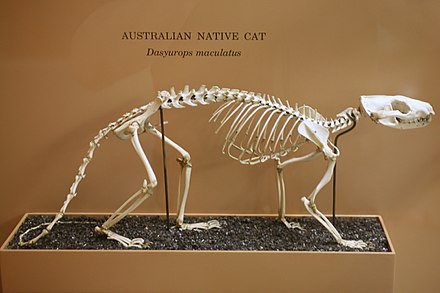Quoll
Quolls (/ˈkwɒlz/; genus Dasyurus) are carnivorous marsupials native to Australia and New Guinea. They are primarily nocturnal and spend most of the day in a den. Of the six species of quoll, four are found in Australia and two in New Guinea. Another two species are known from fossil remains in Pliocene and Pleistocene deposits in Queensland. Genetic evidence indicates that quolls evolved around 15 million years ago in the Miocene, and that the ancestors of the six species had all diverged by around four million years ago. The six species vary in weight and size, from 300 g (11 oz) to 7 kg (15 lb). They have brown or black fur and pink noses. They are largely solitary, but come together for a few social interactions such as mating which occurs during the winter season. A female gives birth to up to 18 pups, of which only six survive because she only has six teats with which to feed them.
Quolls eat smaller mammals, small birds, lizards, and insects. Their natural lifespan is between two and five years. All species have drastically declined in numbers since Australasia was colonised by Europeans, with one species, the eastern quoll, becoming extinct on the Australian mainland, now found only in Tasmania.[2] Major threats to their survival include the toxic cane toad, predators such as feral cats and foxes, urban development, and poison baiting. Conservation efforts include breeding programs in captivity, one of which is taking place in Tasmania with support from Rewilding Australia and Conjour.
The name Dasyurus (from Greek δασύουρος, dasyouros) means "hairy-tail",[3] and was coined by Étienne Geoffroy Saint-Hilaire in 1796.
In 1770, Captain Cook collected quolls on his exploration of the east coast of Australia, adopting an Aboriginal name for the animals.[4] Although the origin of Cook's specimens are unclear, the word and its variants je-quoll, jaquol or taquol are derived from the word dhigul in the language of the Guugu Yimithirr people of far north Queensland. No evidence indicates the local indigenous people used the word in the Sydney area.[5] They were likened in appearance to a polecat or marten in the earliest reports, the tiger quoll being called "spotted marten" and eastern quoll "spotted opossum", but by 1804, the names "native fox", "native cat" and "tiger cat" had been adopted by early settlers; quolls are still called "marsupial foxes" or "marsupial cats".[6]
In the 1960s, noted naturalist David Fleay pushed for the revival of the term "quoll" to replace the then-current vernacular names that he felt were misleading.[7] They are very well known animals in Australia.
Four species have been recovered from Pleistocene cave deposits from Mount Etna Caves National Park near Rockhampton in central Queensland. Remains of the tiger quoll and the northern quoll, and a species either identical or very similar to the eastern quoll, as well as a prehistoric species as yet undescribed, all lived in what was a rainforest climate. The northern quoll is still found in the region.[8] The fossil species D. dunmalli, described by Bartholomai in 1971, is the oldest species recovered to date. Its remains were found in Pliocene deposits near Chinchilla in southeastern Queensland. Known only from a lower jaw and some teeth, it was a relative of the tiger quoll.[9]




